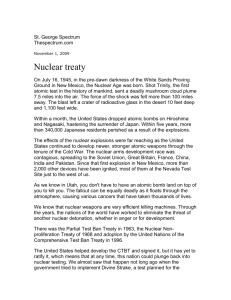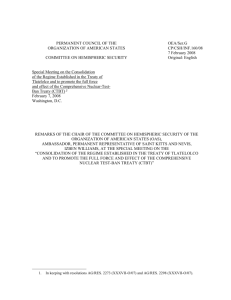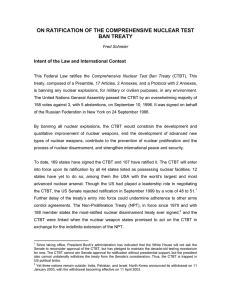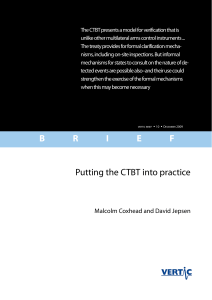as Word - International Commission on Nuclear Non
advertisement
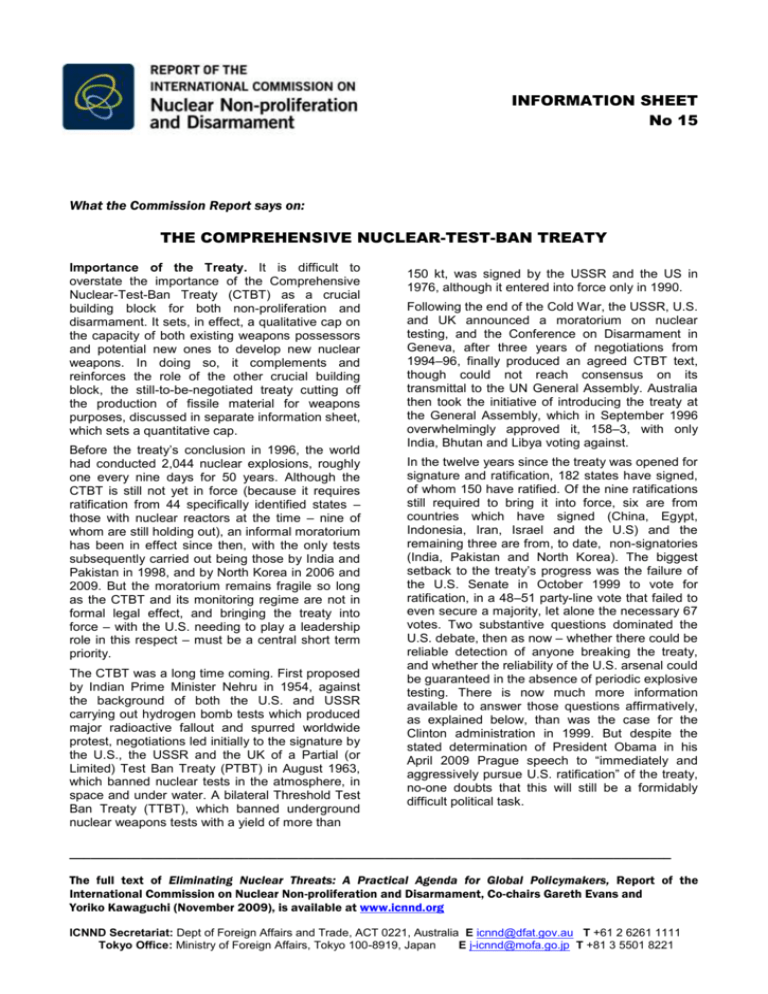
INFORMATION SHEET No 15 What the Commission Report says on: THE COMPREHENSIVE NUCLEAR-TEST-BAN TREATY Importance of the Treaty. It is difficult to overstate the importance of the Comprehensive Nuclear-Test-Ban Treaty (CTBT) as a crucial building block for both non-proliferation and disarmament. It sets, in effect, a qualitative cap on the capacity of both existing weapons possessors and potential new ones to develop new nuclear weapons. In doing so, it complements and reinforces the role of the other crucial building block, the still-to-be-negotiated treaty cutting off the production of fissile material for weapons purposes, discussed in separate information sheet, which sets a quantitative cap. Before the treaty’s conclusion in 1996, the world had conducted 2,044 nuclear explosions, roughly one every nine days for 50 years. Although the CTBT is still not yet in force (because it requires ratification from 44 specifically identified states – those with nuclear reactors at the time – nine of whom are still holding out), an informal moratorium has been in effect since then, with the only tests subsequently carried out being those by India and Pakistan in 1998, and by North Korea in 2006 and 2009. But the moratorium remains fragile so long as the CTBT and its monitoring regime are not in formal legal effect, and bringing the treaty into force – with the U.S. needing to play a leadership role in this respect – must be a central short term priority. The CTBT was a long time coming. First proposed by Indian Prime Minister Nehru in 1954, against the background of both the U.S. and USSR carrying out hydrogen bomb tests which produced major radioactive fallout and spurred worldwide protest, negotiations led initially to the signature by the U.S., the USSR and the UK of a Partial (or Limited) Test Ban Treaty (PTBT) in August 1963, which banned nuclear tests in the atmosphere, in space and under water. A bilateral Threshold Test Ban Treaty (TTBT), which banned underground nuclear weapons tests with a yield of more than 150 kt, was signed by the USSR and the US in 1976, although it entered into force only in 1990. Following the end of the Cold War, the USSR, U.S. and UK announced a moratorium on nuclear testing, and the Conference on Disarmament in Geneva, after three years of negotiations from 1994–96, finally produced an agreed CTBT text, though could not reach consensus on its transmittal to the UN General Assembly. Australia then took the initiative of introducing the treaty at the General Assembly, which in September 1996 overwhelmingly approved it, 158–3, with only India, Bhutan and Libya voting against. In the twelve years since the treaty was opened for signature and ratification, 182 states have signed, of whom 150 have ratified. Of the nine ratifications still required to bring it into force, six are from countries which have signed (China, Egypt, Indonesia, Iran, Israel and the U.S) and the remaining three are from, to date, non-signatories (India, Pakistan and North Korea). The biggest setback to the treaty’s progress was the failure of the U.S. Senate in October 1999 to vote for ratification, in a 48–51 party-line vote that failed to even secure a majority, let alone the necessary 67 votes. Two substantive questions dominated the U.S. debate, then as now – whether there could be reliable detection of anyone breaking the treaty, and whether the reliability of the U.S. arsenal could be guaranteed in the absence of periodic explosive testing. There is now much more information available to answer those questions affirmatively, as explained below, than was the case for the Clinton administration in 1999. But despite the stated determination of President Obama in his April 2009 Prague speech to “immediately and aggressively pursue U.S. ratification” of the treaty, no-one doubts that this will still be a formidably difficult political task. ____________________________________________________________________________________ The full text of Eliminating Nuclear Threats: A Practical Agenda for Global Policymakers, Report of the International Commission on Nuclear Non-proliferation and Disarmament, Co-chairs Gareth Evans and Yoriko Kawaguchi (November 2009), is available at www.icnnd.org ICNND Secretariat: Dept of Foreign Affairs and Trade, ACT 0221, Australia E icnnd@dfat.gov.au T +61 2 6261 1111 Tokyo Office: Ministry of Foreign Affairs, Tokyo 100-8919, Japan E j-icnnd@mofa.go.jp T +81 3 5501 8221 Of the remaining holdout states, there is strong basic support for the treaty in China and Indonesia. Indonesia has announced it is proceeding with ratification, and China’s ratification can certainly be expected if the U.S. moves. The Middle East trio of Egypt, Iran and Israel are more problematic, with all supporting the treaty in principle, but each inclined to make ratification conditional at least on that of the others (and with Egypt, for one, insisting that Israel has to first join the NPT): in breaking out of that circle, much will clearly depend on how the current Iran issue is resolved, but movement on a wider regional peace front may also be a precondition. In South Asia, Pakistan is likely to take its cue from India, which – despite longstanding general support in principle – has never found the time ripe for acceptance in practice, in the absence of significant movement on disarmament by the original nuclearweapon states. India’s current position is that it will reconsider its position “if the world moves categorically toward nuclear disarmament in a credible time frame”, which – if international momentum continues to build in the way described and recommended in this report – gives some hope for a more accommodating stance. Whether North Korea will ever join the treaty clearly depends on the resolution of the current much broader dispute about its nuclear aspirations and behaviour. What is clear is that U.S. ratification would be a circuit-breaker, having an immediate impact on the other CTBT hold-out states, and creating much new momentum in itself for the broader non-proliferation and disarmament agenda. What the non-nuclear armed states have long argued for – along with those like India and Pakistan reluctant to accept formal NPT and other treaty disciplines – is an evident sense of seriousness on the part of the inner core of nuclear-weapon states that they really do want to move toward a nuclear weapon free world, and U.S. ratification of the CTBT would provide real evidence of that. It becomes extremely important, again, in this context, to fully answer the concerns which have been articulated about verification effectiveness and ensuring stockpile reliability in the absence of testing: doing so may not be a sufficient condition for garnering 67 Senate votes, but it is certainly a necessary one. Verification Concerns. Even though the CTBT is not in force, a great deal of progress has been made in developing the complex verification infrastructure it provides for – the International Monitoring System (IMS). A functioning treaty organization, albeit with a transitional name, the “Preparatory Commission for the Comprehensive Nuclear-Test-Ban Treaty Organization”, is alive and well and living in Vienna, with a budget of $111 million, and universally known as the CTBTO. The IMS will involve, when complete – and it is close to 80 per cent ready now (with the major remaining task being to improve coverage in the West Asia area) – 337 monitoring stations on land and at sea worldwide, applying four distinct technologies: seismic, radionuclide, hydro-acoustic and infrasound. Those stations already send a constant flow of information via satellite to a sophisticated International Data Centre (IDC), which monitors and analyses the data, and makes it available to states parties to the treaty, both in distilled and raw form. Many states, in turn, operate national data centres (NDCs) to identify and further analyse events that are of interest and possible concern to them, using where applicable their own “national technical means”. The treaty provides for a state party to demand onsite inspection (OSI) in the event of a suspicious event being detected, and this is approved by 30 of the 51 members of the treaty’s Executive Council. This would be particularly useful in situations where the evidence is ambiguous or incomplete, for example with seismic but no radionuclide data. The CTBTO has held field exercises – including a very major one at the former Soviet test site at Semipalatinsk in Kazakhstan in 2008 – to test the technologies involved, including visual ground inspection, over-flights, local seismic networks, radionuclide monitoring and ground-penetrating radar. Concerns were expressed from the outset, and particularly in the U.S. Senate debate in 1999, that the proposed IMS would, for all its complex coverage, be unable to detect low-yield underground tests: the originally anticipated detectable yield of around 1 kiloton was seen as too high. But innovations in monitoring technologies over the years mean that the system can detect an explosion of as little as 0.1 kt in most parts of the world, and a 0.01 kt (i.e. equivalent to 10 tons of TNT) explosion in many critical regions. Although the North Korean underground test in 2006 had an estimated yield of only around 0.5 kt, it was detected by 22 IMS seismic stations, including one 7,000 km away. And a gas from the test, xenon-133, emitted in minute quantities from ground fissures, was detected twelve days later by a radionuclide station in Canada. The May 2009 North Korean test, somewhat larger, was picked up by 61 seismic stations. Very small nuclear explosions – smaller than those now readily detectable, or which will be when the full complement of monitoring stations is in place – are generally thought to be beyond the capacity of any country without significant nuclear test experience, and to have in any event no strategic value. The CTBT presents a model for verification that is unlike other multilateral arms control instruments. It provides that responsibility for analysis of verification data, and judgments on compliance, lies with states parties. As preparations have been made for the treaty's entry into force, focus has naturally fallen on the development of the CTBTO-developed and operated infrastructure just described – and clearly an effective and adequately resourced CTBTO will be crucial in effectively implementing the treaty’s detection mechanisms. But individual states also have to establish their own national data centres, and 2 there is much that many of them can do with their own information gathering resources. More attention needs to be paid to developing cooperative arrangements for the further integration of all these components. Stockpile Reliability Concerns. While the CTBT is interpreted to allow for non-explosive (or sub-critical) tests, its ban on nuclear test explosions clearly significantly restricts, as it is meant to do, one major avenue of scientific enquiry. The question – particularly resonant in the U.S., not least its Senate – is whether this inhibits the capacity to discover and resolve potential problems that might affect weapon safety or reliability. The short answer is that it does not, on the basis of analysis and experience so far in the U.S. and elsewhere, but the issue will no doubt continue to generate lively debate. An authoritative contribution to finally resolving the issue seems likely to be made by the National Academies Committee on International Security and Arms Control (NASCISAC) which has been tasked by the Obama administration to review and update its earlier 2002 study, widely regarded as definitive. The last U.S. test was in 1992, and in the years since it has relied on a combination of computer simulation, non-nuclear explosive testing and scientific research, referred to as the Stockpile Stewardship Program (SSP). This SSP has involved the re-manufacture of some weapons components to overcome effects of ageing, but has not altered the design of the nuclear explosive package at the centre of a weapon. It has also investigated the longevity of current weapons, and has usefully assuaged concerns about, for example, the deterioration over time of the plutonium core. Technical assessment of the success of the SSP for extending the life of current weapons has been positive. Whether life extension activities are sufficient for the long term (twenty or more years in the future) continues to be questioned, however, by those who see a wider role for the SSP, including the development and deployment of new weapon designs. The concept of a Reliable Replacement Warhead (RRW) – though shelved by the Obama administration – continues to surface in debate as a means of modernising U.S. nuclear weapons, ensuring their long term reliability without nuclear explosive testing. Even if the CTBT were not directly breached, it would raise questions about its value – and certainly undermine the presentational impact worldwide of U.S. ratification of it – if new weapon designs could be developed, especially ones with a new military role. It may be, however, that this dilemma can be navigated. The 2009 report of the Congressional Commission on the Strategic Posture of the United States – headed by two former Defense secretaries of rather different outlooks on these matters, William Perry and James Schlesinger – notes that there is a third position available between the two ends of the spectrum (“the pure remanufacturing of existing warheads with existing components at one end, and complete redesign and new production of all system components at the other”), viz. “various options to utilize existing components and design solutions while mixing in new components and solutions as needed.” Given the success of life extension under the SSP, it seems likely that judicious use of new components and design solutions, as they may become necessary, could continue to give assurance about safety and reliability over the long term, but minimize the risk of international reaction associated with the development of a new design. The other nuclear-weapon states that have ratified the CTBT have substantial stockpile stewardship programs without significant concerns being expressed about the constraints imposed by the treaty. The UK continues to conduct active research and other activities though its Atomic Weapons Establishment to maintain its nuclear weapons, clearly premised on no nuclear testing, as does the French Atomic Energy Commission which test’s the country’s nuclear arsenal through simulations using advanced equipment. Stockpile stewardship in Russia is managed through the state corporation Rosatom, which pools the institutions working on military programs, the research institutes and nuclear safety agencies. Recommendations: All states that have not already done so should sign and ratify the CTBT unconditionally and without delay. Pending entry into force, all states should continue to refrain from nuclear testing. All signatories should provide the necessary financial, technical and political support for the continued development and operation of the CTBTO, including completing the global coverage of its monitoring systems, facilitating on-site inspection when warranted, and establishing effective national data centres and information gathering systems. [Section 11, Recs 20, 21] 3



